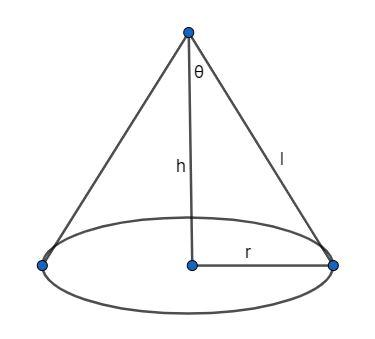Answer
414.9k+ views
Hint:First we will draw the figure of a cone and then using all the values that are given in the question we will find the volume of the cone. After we know that the volume of the smaller cone will be $\dfrac{1}{27}$ of the larger cone and by using this much information we will find the height of the smaller cone.
Complete step-by-step answer:

The value of h = 30 cm and r = radius of base.
Let $\theta $ be the angle between height (h) and slant height (l) in the above figure.
The formula for volume of cone is $\dfrac{\pi {{r}^{2}}h}{3}$ .
A right angle triangle is formed where base = radius, height = h and hypotenuse = slant height.
As we know $\tan \theta =\dfrac{base}{height}$ .
From above we get $\tan \theta =\dfrac{r}{h}$ $\Rightarrow r=h\tan \theta $………….. (1)
After cutting the cone, let the height of the smaller cone be h’ and radius be r’.
The relation between h’ and r’ is $r'=h'\tan \theta $ …………….. (2)
Now the volume of larger cone using equation (1) is $\dfrac{\pi {{r}^{2}}h}{3}$=$\dfrac{\pi {{h}^{3}}{{\tan }^{2}}\theta }{3}$ …………. (3)
Now the volume of smaller cone using equation (2) is $\dfrac{\pi r{{'}^{2}}h'}{3}=\dfrac{\pi h{{'}^{3}}{{\tan }^{2}}\theta }{3}$………….. (4)
We know that the volume of a smaller cone will be $\dfrac{1}{27}$ of the larger cone.
So, $\dfrac{equation(4)}{equation(3)}=\dfrac{1}{27}$
$\begin{align}
& \Rightarrow \dfrac{\dfrac{\pi h{{'}^{3}}{{\tan }^{2}}\theta }{3}}{\dfrac{\pi {{h}^{3}}{{\tan }^{2}}\theta }{3}} \\
& \Rightarrow \dfrac{h{{'}^{3}}}{{{h}^{3}}}=\dfrac{1}{27} \\
& \\
& \Rightarrow h{{'}^{3}}=\dfrac{{{h}^{3}}}{27} \\
& \Rightarrow h'=\dfrac{h}{3}=\dfrac{30}{3}=10 \\
\end{align}$
Therefore, h’ = 10 cm.
Note: In this question the important part is to understand how we substituted the radius in terms of height with the use of angle because in both smaller and larger cones the angle $\theta $ is the same hence, we used this fact to convert our volume equation containing the only variable height.Students should not get confuse with slant height and height of the cone as they are both different as shown in the figure.
Complete step-by-step answer:

The value of h = 30 cm and r = radius of base.
Let $\theta $ be the angle between height (h) and slant height (l) in the above figure.
The formula for volume of cone is $\dfrac{\pi {{r}^{2}}h}{3}$ .
A right angle triangle is formed where base = radius, height = h and hypotenuse = slant height.
As we know $\tan \theta =\dfrac{base}{height}$ .
From above we get $\tan \theta =\dfrac{r}{h}$ $\Rightarrow r=h\tan \theta $………….. (1)
After cutting the cone, let the height of the smaller cone be h’ and radius be r’.
The relation between h’ and r’ is $r'=h'\tan \theta $ …………….. (2)
Now the volume of larger cone using equation (1) is $\dfrac{\pi {{r}^{2}}h}{3}$=$\dfrac{\pi {{h}^{3}}{{\tan }^{2}}\theta }{3}$ …………. (3)
Now the volume of smaller cone using equation (2) is $\dfrac{\pi r{{'}^{2}}h'}{3}=\dfrac{\pi h{{'}^{3}}{{\tan }^{2}}\theta }{3}$………….. (4)
We know that the volume of a smaller cone will be $\dfrac{1}{27}$ of the larger cone.
So, $\dfrac{equation(4)}{equation(3)}=\dfrac{1}{27}$
$\begin{align}
& \Rightarrow \dfrac{\dfrac{\pi h{{'}^{3}}{{\tan }^{2}}\theta }{3}}{\dfrac{\pi {{h}^{3}}{{\tan }^{2}}\theta }{3}} \\
& \Rightarrow \dfrac{h{{'}^{3}}}{{{h}^{3}}}=\dfrac{1}{27} \\
& \\
& \Rightarrow h{{'}^{3}}=\dfrac{{{h}^{3}}}{27} \\
& \Rightarrow h'=\dfrac{h}{3}=\dfrac{30}{3}=10 \\
\end{align}$
Therefore, h’ = 10 cm.
Note: In this question the important part is to understand how we substituted the radius in terms of height with the use of angle because in both smaller and larger cones the angle $\theta $ is the same hence, we used this fact to convert our volume equation containing the only variable height.Students should not get confuse with slant height and height of the cone as they are both different as shown in the figure.
Recently Updated Pages
Assertion The resistivity of a semiconductor increases class 13 physics CBSE

The Equation xxx + 2 is Satisfied when x is Equal to Class 10 Maths

How do you arrange NH4 + BF3 H2O C2H2 in increasing class 11 chemistry CBSE

Is H mCT and q mCT the same thing If so which is more class 11 chemistry CBSE

What are the possible quantum number for the last outermost class 11 chemistry CBSE

Is C2 paramagnetic or diamagnetic class 11 chemistry CBSE

Trending doubts
Difference between Prokaryotic cell and Eukaryotic class 11 biology CBSE

Difference Between Plant Cell and Animal Cell

Select the word that is correctly spelled a Twelveth class 10 english CBSE

Fill the blanks with the suitable prepositions 1 The class 9 english CBSE

What is the z value for a 90 95 and 99 percent confidence class 11 maths CBSE

Give 10 examples for herbs , shrubs , climbers , creepers

What organs are located on the left side of your body class 11 biology CBSE

What is BLO What is the full form of BLO class 8 social science CBSE

Change the following sentences into negative and interrogative class 10 english CBSE



